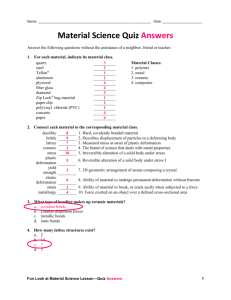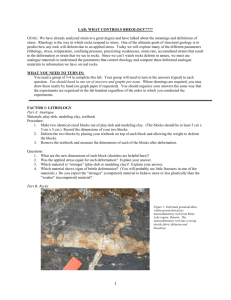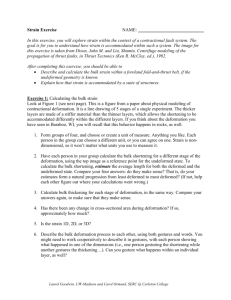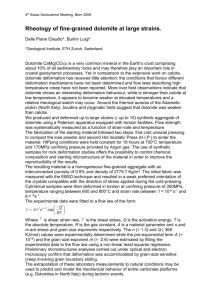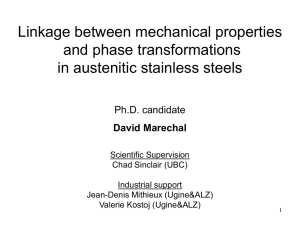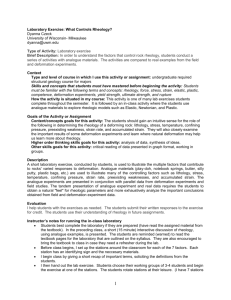parameter 4: confining pressure
advertisement
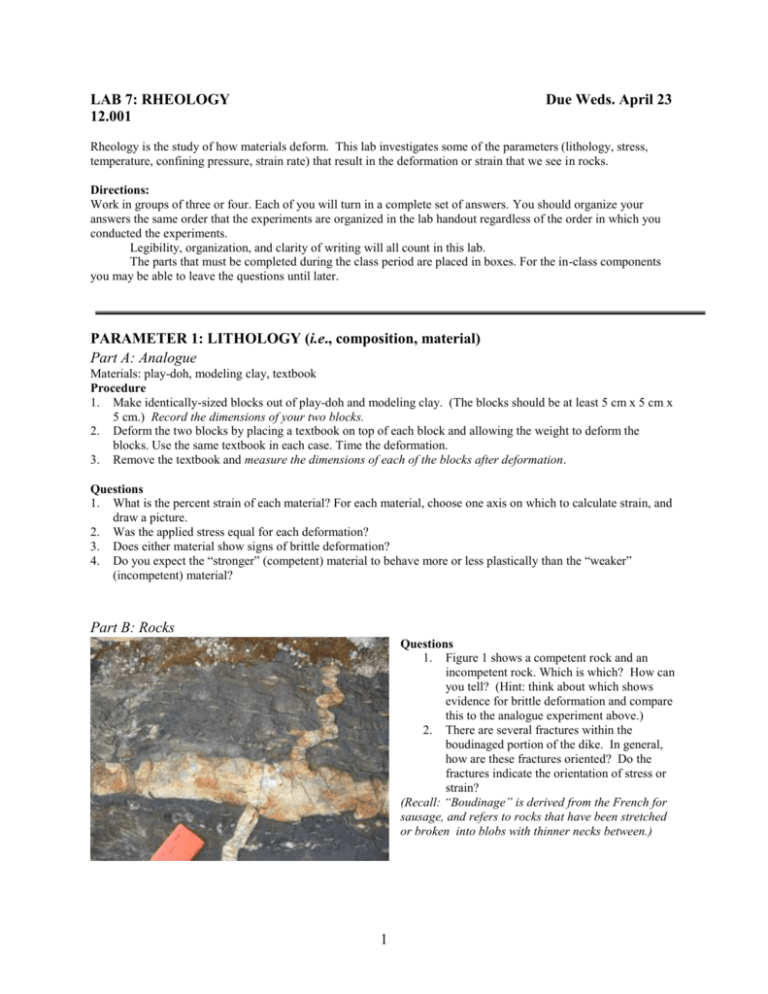
LAB 7: RHEOLOGY 12.001 Due Weds. April 23 Rheology is the study of how materials deform. This lab investigates some of the parameters (lithology, stress, temperature, confining pressure, strain rate) that result in the deformation or strain that we see in rocks. Directions: Work in groups of three or four. Each of you will turn in a complete set of answers. You should organize your answers the same order that the experiments are organized in the lab handout regardless of the order in which you conducted the experiments. Legibility, organization, and clarity of writing will all count in this lab. The parts that must be completed during the class period are placed in boxes. For the in-class components you may be able to leave the questions until later. PARAMETER 1: LITHOLOGY (i.e., composition, material) Part A: Analogue Materials: play-doh, modeling clay, textbook Procedure 1. Make identically-sized blocks out of play-doh and modeling clay. (The blocks should be at least 5 cm x 5 cm x 5 cm.) Record the dimensions of your two blocks. 2. Deform the two blocks by placing a textbook on top of each block and allowing the weight to deform the blocks. Use the same textbook in each case. Time the deformation. 3. Remove the textbook and measure the dimensions of each of the blocks after deformation. Questions 1. What is the percent strain of each material? For each material, choose one axis on which to calculate strain, and draw a picture. 2. Was the applied stress equal for each deformation? 3. Does either material show signs of brittle deformation? 4. Do you expect the “stronger” (competent) material to behave more or less plastically than the “weaker” (incompetent) material? Part B: Rocks Questions 1. Figure 1 shows a competent rock and an incompetent rock. Which is which? How can you tell? (Hint: think about which shows evidence for brittle deformation and compare this to the analogue experiment above.) 2. There are several fractures within the boudinaged portion of the dike. In general, how are these fractures oriented? Do the fractures indicate the orientation of stress or strain? (Recall: “Boudinage” is derived from the French for sausage, and refers to rocks that have been stretched or broken into blobs with thinner necks between.) 1 PARAMETER 2: STRESS Part A: Analogue 1 Materials: play-doh, textbook, ruler. Procedure In PARAMETER 1 you made a tower of play-doh and deformed it with a textbook. 1. Calculate the stress on the play-doh tower from PARAMETER 1 (you may guess the mass of your textbook or you may weigh it). 2. Design a second experiment with play-doh and books that will produce twice the stress of your first experiment. Draw a diagram, do the experiment, record the result. Time the deformation. Questions 1. What can you conclude about the effect of increasing stress on the resulting deformation? 2. Calculate the viscosity for PARAMETER 1 and for this experiment. Are they different? Do the values seem reasonable? Why or why not? Part A: Analogue 2 Materials: Imaginary spring. Thought experiment about a metal spring. Recall that stress can produce compression (as above), tension, or shear. Questions 1. Describe a way to deform a spring that results in elastic behavior. 2. Describe a way to deform a spring that results in plastic behavior. 3. Describe a way to deform a spring that results in fracture. 2 PARAMETER 3: TEMPERATURE Part A: Analogue Materials: 2 sticks of butter: One room temperature and one refrigerated Procedure So as not to waste too much butter, we will conduct this experiment in larger groups. 1. Slightly open the warm butter package and slowly fold it with your hands. 2. Slightly open the cold butter package and slowly fold it with your hands. Questions 1. Based on your observations, is an increase in temperature more likely to cause materials to strain plastically or elastically? 2. Based on your observations, is an increase in temperature more likely to cause materials to have brittle or ductile deformation? 3. Where did you see fractures in the cold butter? (Explain the orientation; a sketch will make this easier.) 4. Where did you see fractures in the warm butter? (Explain the orientation; a sketch will make this easier.) Part B: Griggs et al. deformation experiment for basalt under various temperatures Figure 3: Stress-strain diagram for basalt deformed at 5 kbar confining pressure under a variety of temperature conditions. From Griggs, Turner, and Heard (1960). Graph copied from Davis and Reynolds (1996). Questions 1. Review Figure 3. Under what temperature is the basalt “strongest?” 2. Give the strain at which the basalt ruptured for each temperature experiment. 3. What was the stess at which the basalt at 25°, 300°, 500°, 700°, and 800° ruptured? Describe the general trend. What factors do you think might make this general trend an imperfect relationship? 3 PARAMETER 4: CONFINING PRESSURE Part A: Donath’s experiments for rocks under various confining pressures Figure 4 is from a famous experiment by Fred Donath. It shows specimens of limestone that were deformed to approximately the same total strain (15%) at different confining pressures. Figure 4: Specimens of limestone deformed to approximately the same total strain (about 15%) at different confining pressures. Increased confining pressure causes a transition fin deformational mode from brittle to ductile faulting. From Donath (1970). Figure copied from Davis and Reynolds (1996). Figure 5 is also from Donath’s experiment. It shows a graph between the differential stress and strain for the limestone deformation experiment (specimens shown above). Questions 1. At what confining pressure is the rock “strongest?” 2. At what confining pressure is there more ductile deformation? Figure 5: Stress-strain diagrams for limestone deformed at a variety of confining pressures. Tests conducted at room temperature. The magnitude of confining pressure (in MPa) for each run is shown next to each curve. Both strength and plasticity increase with greater confining pressure. From Donath (1970). Figure copied from Davis and Reynolds (1996). 4 PARAMETER 5: STRAIN RATE Part A: Analogue experiment Materials: silly putty Procedure 1. Roll the silly putty into a small sausage shape. 2. Pull QUICKLY on the silly putty and watch it deform. 3. Roll the silly putty into a small sausage shape. 4. Pull SLOWLY on the silly putty and watch it deform. Questions 1. Does a slower strain rate favor plastic or elastic deformation? 2. Does the prevalence of lovely ductile deformation structures (such as shear zones) at depth within deformed regions of the crust suggest that strain rates within the earth are typically fast or slow? Part B: Yule Marble deformation experiments Review Figure 7. Questions 1. Are rocks “stronger” or “weaker” at faster strain rates? Explain your answer. 2. Under the same stress, would you expect to measure more strain (such as in a deformed belemnite) at higher or lower strain rates? References: Davis, G. H., and Reynolds, S. J. 1996. Structural Geology of Rocks and Regions, 2 nd edition. New York: John Wiley & Sons, p. 132-137. Donath, F. A., 1970. Some information squeezed out of rock. American Scientist 58, 54-72. Griggs, D. T., Turner, F. J., and Heard, H. C., 1960. Deformation of rocks at 500° to 800° C, in Griggs, D. T., and Handin, J. (eds.), Rock deformation: Geological Society of America Memoir 79, 39-104. Heard, H. C., 1963. Effect of large changes in strain rate in the experimental deformation of Yule marble. Journal of Geology 71, 162-195. 5


